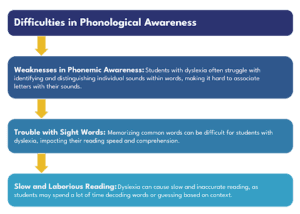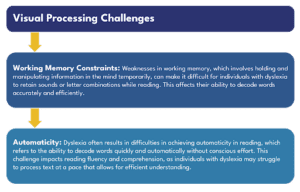Understanding the signs of dyslexia in students is more than an educational necessity; it’s a pathway to unlocking their full potential. Early identification of dyslexia is pivotal, not just for academic success, but also for nurturing the overall well-being of the child. This blog series will delve into the warning signs of dyslexia, emphasizing the transformative power of early intervention. By understanding and addressing the reading challenges faced by students with dyslexia, educators and parents can help these students develop their reading skills and foster a love for reading.
What Is Dyslexia?
It is important to emphasize that dyslexia is not a result of inadequate intelligence or a lack of motivation to learn. Instead, it reflects variations in cognitive processing. By employing appropriate teaching methodologies that cater to their specific needs, teachers can support students facing dyslexia and help them to achieve academic success (The International Dyslexia Association (IDA) thanks Louisa C. Moats, Ed.D., and Karen E. Dakin, M.Ed., for their assistance in the preparation of this fact sheet).
Consider this progression: “The five-year-old who can’t quite learn her letters becomes the six-year-old, who can’t match sounds to letters. By age 11 she is the child who would rather hide in the school bathroom than read out loud in class. At 18, her excruciatingly slow reading makes it nearly impossible to finish important tests in the allotted time—potentially hurting her college and career prospects (Yale Dyslexia).”
Identifying the Warning Signs of Dyslexia
Warning signs of dyslexia can start to emerge in preschool-aged children, typically between the ages of 3 and 5. However, it’s important to note that every child develops at their own pace, and while some warning signs may be present, it is not indicative of an individual having dyslexia and ultimately, should receive personalized intervention.
Once a student starts formal schooling, typically in kindergarten, students with dyslexia often struggle with decoding due to underlying difficulties in phonological processing. Decoding involves translating written symbols (letters or letter combinations) into the corresponding speech sounds and then blending those sounds together to form words.
Difficulties in Phonological Awareness
Dyslexia is mainly characterized by difficulties in phonological awareness and the ability to recognize and manipulate the sounds of language. These challenges can manifest in these key areas:
Weaknesses in Phonemic Awareness
Students with dyslexia often struggle with identifying and distinguishing individual sounds within words, making it hard to associate letters with their sounds.
Trouble with Sight Words
Memorizing common words can be difficult for students with dyslexia, impacting their reading speed and comprehension.
Slow and Laborious Reading
Dyslexia can cause slow and inaccurate reading, as students may spend a lot of time decoding words or guessing based on context.

Visual Processing Challenges
While dyslexia primarily affects language processing, some individuals with dyslexia may also have visual processing difficulties. They may struggle to accurately perceive and process visual information, which can further impede their ability to recognize and decode written words. Issues with visual memory and processing can significantly affect learning and retention for students with dyslexia.
Working Memory Constraints
Weaknesses in working memory, which involves holding and manipulating information in the mind temporarily, can make it difficult for individuals with dyslexia to retain sounds or letter combinations while reading. This affects their ability to decode words accurately and efficiently.
Automaticity
Dyslexia often results in difficulties in achieving automaticity in reading, which refers to the ability to decode words quickly and automatically without conscious effort. This challenge impacts reading fluency and comprehension, as individuals with dyslexia may struggle to process text at a pace that allows for efficient understanding.

Impact of Dyslexia on Reading and Writing Skills
Ultimately, unassisted dyslexia can lead to persistent and prolonged issues with spelling and writing tasks, potentially resulting in avoidance of reading or writing activities.
Signs include:
- Persistent spelling errors
- Struggles with learning spelling rules
- Trouble recalling spelling rules
- Poor handwriting
- Difficulties organizing thoughts on paper
- Challenges with grammar
When you know the warning signs to look for, early detection and intervention can be the key to student success. But when this signs are overlooked or ignored, undetected dyslexia can lead to more severe delays. The most crucial part of this puzzle is when detection happens – the earlier, the better.
Undetected Dyslexia & Early Intervention
Delays in breaking phonetic codes from early elementary school can lead to a child missing out on crucial reading practice, hindering the development of fluency and vocabulary. At about fourth grade, the pivotal transition from learning to read to reading for comprehension occurs. At this point, children with dyslexia may struggle even more to grasp essential skills and acquire knowledge through reading.
Despite growing awareness, many children with dyslexia go undetected until fifth grade or later. This delay is worrisome, especially considering that intervention effectiveness notably decreases after the third grade. A recent study published in the Journal of Educational Psychology found that early intervention resulted in nearly double the reading improvement compared to interventions provided in the third grade.
Additionally, first-graders who received early intervention showed even greater progress than their second-grade counterparts, emphasizing the critical significance of identifying dyslexia at an early stage.
Creating a supportive and inclusive learning environment for students with dyslexia is crucial for several reasons, each contributing to the holistic development and success of these students. Such an environment not only addresses the academic challenges associated with dyslexia but also nurtures the emotional and social well-being of these learners.
Blog Series – Unlocking Success for Students with Dyslexia
Join MindPlay as we explore how to best support students with dyslexia or those who may show early warning signs in this blog series – Unlocking Success with Dyslexia.
Be sure to read the rest of the series, including:
Specific Strategies to Support Students with Dyslexia
Fostering a Supportive Environment for Students with Dyslexia
Share with Us!
We encourage readers to share their experiences or insights on identifying and supporting students with dyslexia. Resources are available for further reading and support. To delve deeper into understanding and identifying the signs of dyslexia, contact MindPlay for more information on Signals and support systems designed to aid both educators and parents in this crucial endeavor.
Resources
Hendren, R. L., Haft, S. L., Black, J. M., White, N. C., & Hoeft, F. (2018). Recognizing Psychiatric Comorbidity With Reading Disorders. Frontiers in Psychiatry, 9.
Lovett, M. W., Frijters, J. C., Wolf, M., Steinbach, K. A., Sevcik, R. A., & Morris, R. D. (2017). Early intervention for children at risk for reading disabilities: The impact of grade at intervention and individual differences on intervention outcomes. Journal of Educational Psychology, 109(7), 889–914. https://doi.org/10.1037/edu0000181
Quratulain., Ghazanfar, S.,& Sattar, A.(2023).A Computer-Based Method to Improve the Spelling of a Learner with Dyslexia. Journal of Social Sciences Review, 3(1), 235-243.
Yale Dyslexia. (n.d.). Suspect dyslexia? act early. Yale University. https://dyslexia.yale.edu/resources/parents/what-parents-can-do/suspect-dyslexia-act-early/
